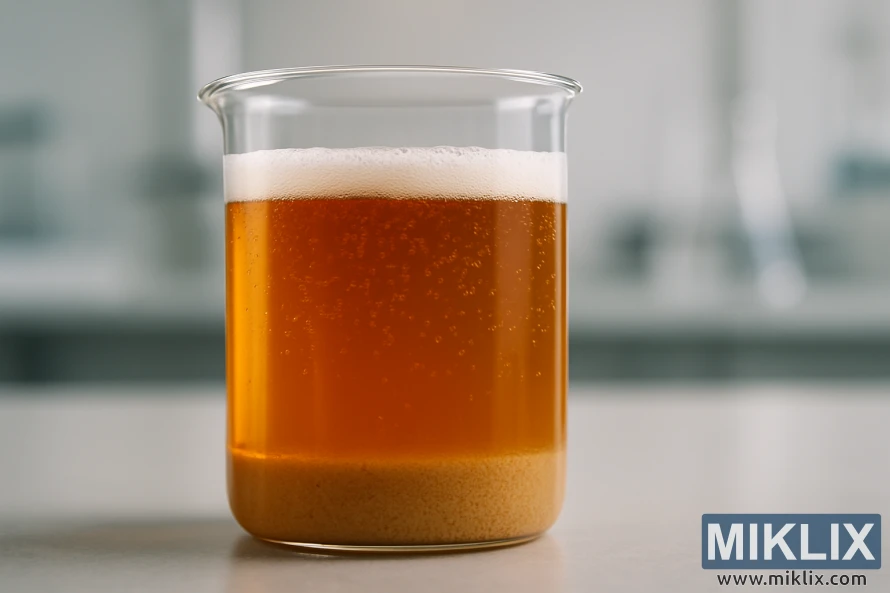Image: Yeast Flocculation Study
Published: September 30, 2025 at 11:04:50 PM UTC
Close-up of a lab beaker with Belgian Abbey Ale, highlighting yeast flocculation layers in a scientific yet artistic composition.
The image presents a highly detailed, macro-level view of a laboratory beaker containing a sample of Belgian Abbey Ale in the midst of yeast flocculation. The subject is captured in sharp focus, while the background remains gently blurred, allowing the viewer’s attention to rest squarely on the golden-hued liquid and its distinct layers. The composition is both scientific and artistic, balancing technical precision with visual elegance.
At the center of the frame sits a clear cylindrical beaker made of smooth, transparent laboratory glass. Its lip curves outward gently, catching a subtle glint of light that emphasizes the material’s clarity and purity. Unlike marked measuring glassware, this vessel is deliberately minimal, free from distracting scales or labels, underscoring the visual focus on the beer itself. The glass rests on a clean, pale countertop, the reflective surface subtly echoing the amber tones of the liquid inside. The environment surrounding the beaker is modern and clinical—hints of blurred lab equipment and shelving are visible in the soft-focus background, yet they recede into abstraction, suggesting sterility and order without drawing attention away from the foreground.
Inside the beaker, the beer presents itself in layers that reveal the natural dynamics of fermentation and yeast behavior. The upper portion of the liquid glows with a translucent amber-golden hue, radiant yet warm, recalling sunlight passing through honey. Suspended within this layer, tiny bubbles of carbon dioxide rise steadily to the surface, creating a delicate effervescence that imparts vitality and motion. The bubbles catch the light, shimmering like minute points of silver within the deeper amber body.
Just below the surface lies a thin, pale cap of foam. This foamy crown is not exaggerated or theatrical, but modest and compact, suggesting a controlled pour suitable for laboratory study rather than casual drinking. Its white-to-ivory color contrasts gently against the beer’s golden depths, forming a soft dividing line between liquid and air.
The lower portion of the beaker tells a more technical and fascinating story. At the very bottom, a dense layer of sediment has accumulated, forming a clearly visible foundation of flocculated yeast particles. The sediment is thick and creamy in texture, its beige-to-tan coloration creating a striking contrast with the transparent amber liquid above. This base layer illustrates the phenomenon of yeast flocculation with remarkable clarity: cells once suspended in the liquid have bound together, clumped, and settled, leaving behind a liquid phase that grows progressively clearer as it rises toward the top of the beaker.
The transition between layers is gradual rather than abrupt. Just above the sediment, the beer is slightly hazy, with visible particulate matter still in slow descent. Moving upward, the haze gives way to clarity, until the upper third of the liquid shines nearly transparent, a vivid demonstration of the sedimentation process in action. This gradient of clarity—from opaque at the base, to translucent in the middle, to crystalline at the top—serves as a textbook example of brewing science captured in real time.
The lighting is deliberately soft and diffused, streaming in from an off-camera source, perhaps a laboratory window or an overhead fixture. It casts subtle highlights on the glass’s curved edges and brings out the amber brilliance of the liquid, while also creating delicate shadows that accentuate the depth and density of the sediment. The interplay of light and shadow emphasizes the textures of foam, bubbles, and sediment, lending the image both dimensionality and tactility.
The overall mood of the picture is one of scientific inquiry and precision, tempered by the organic beauty of the brewing process. This is not an image of ale as a finished beverage ready for consumption, but rather as a subject of analysis—a data point in a broader investigation into yeast behavior, fermentation kinetics, and the craftsmanship of Belgian abbey brewing. It conveys respect for tradition while placing emphasis on the rigor of modern laboratory study, blending artisanal heritage with empirical science.
The image is related to: Fermenting Beer with White Labs WLP500 Monastery Ale Yeast

